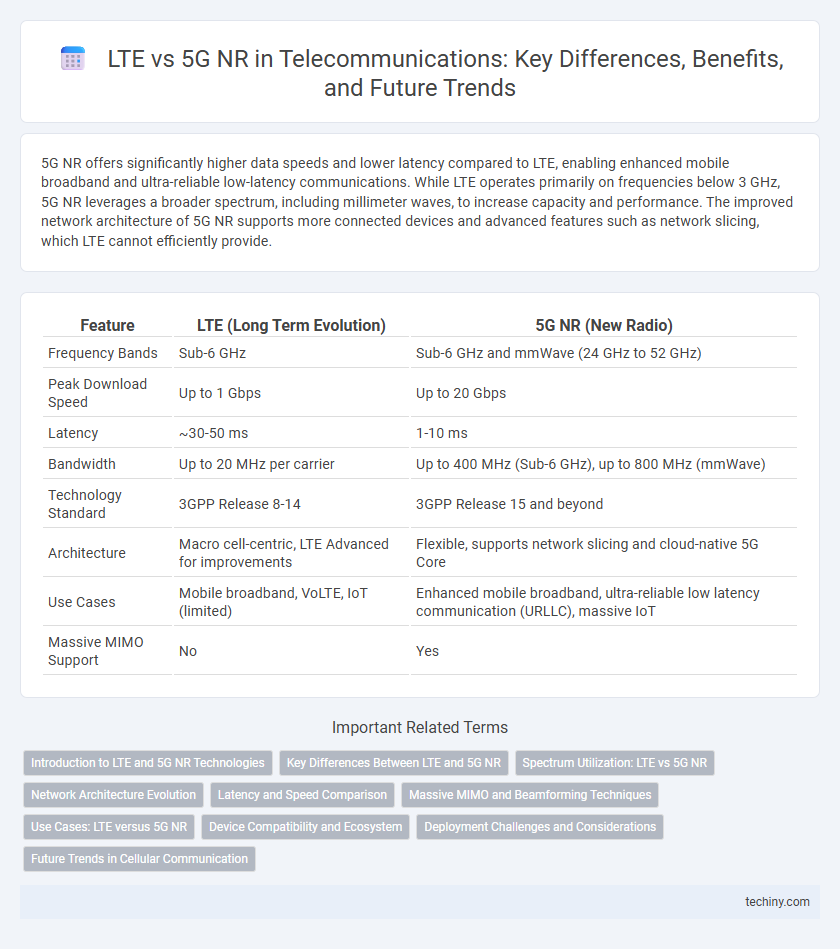5G NR offers significantly higher data speeds and lower latency compared to LTE, enabling enhanced mobile broadband and ultra-reliable low-latency communications. While LTE operates primarily on frequencies below 3 GHz, 5G NR leverages a broader spectrum, including millimeter waves, to increase capacity and performance. The improved network architecture of 5G NR supports more connected devices and advanced features such as network slicing, which LTE cannot efficiently provide.
Table of Comparison
| Feature | LTE (Long Term Evolution) | 5G NR (New Radio) |
|---|---|---|
| Frequency Bands | Sub-6 GHz | Sub-6 GHz and mmWave (24 GHz to 52 GHz) |
| Peak Download Speed | Up to 1 Gbps | Up to 20 Gbps |
| Latency | ~30-50 ms | 1-10 ms |
| Bandwidth | Up to 20 MHz per carrier | Up to 400 MHz (Sub-6 GHz), up to 800 MHz (mmWave) |
| Technology Standard | 3GPP Release 8-14 | 3GPP Release 15 and beyond |
| Architecture | Macro cell-centric, LTE Advanced for improvements | Flexible, supports network slicing and cloud-native 5G Core |
| Use Cases | Mobile broadband, VoLTE, IoT (limited) | Enhanced mobile broadband, ultra-reliable low latency communication (URLLC), massive IoT |
| Massive MIMO Support | No | Yes |
Introduction to LTE and 5G NR Technologies
LTE (Long Term Evolution) revolutionized mobile communication by offering high-speed data and improved network capacity, serving as the foundation for 4G networks. 5G NR (New Radio) builds upon LTE by providing ultra-low latency, enhanced bandwidth, and massive connectivity to support diverse applications like IoT, autonomous vehicles, and immersive media. Both technologies utilize advanced OFDM-based air interfaces but 5G NR leverages wider frequency ranges and sophisticated antenna techniques to achieve unprecedented performance.
Key Differences Between LTE and 5G NR
LTE operates on frequencies below 6 GHz, utilizing OFDM for downlink and SC-FDMA for uplink, while 5G NR supports a wider spectrum range including millimeter wave bands above 24 GHz, enabling significantly higher bandwidth and reduced latency. 5G NR employs a flexible numerology and advanced beamforming techniques that enhance network capacity and reliability compared to LTE's fixed subcarrier spacing and traditional MIMO configurations. Core network architecture also differs, with 5G NR integrating a service-based architecture facilitating network slicing and edge computing, whereas LTE relies on a more rigid EPC framework.
Spectrum Utilization: LTE vs 5G NR
5G NR significantly improves spectrum utilization compared to LTE by supporting wider bandwidths up to 400 MHz in mmWave bands, whereas LTE maxes out at 20 MHz per carrier. Advanced technologies such as dynamic spectrum sharing (DSS) enable 5G NR to coexist with LTE in the same frequency bands, optimizing overall spectral efficiency. Enhanced modulation schemes like 256-QAM in 5G NR further increase data throughput, maximizing the capacity of available spectrum resources.
Network Architecture Evolution
The network architecture of 5G NR (New Radio) represents a significant evolution from LTE, introducing a flexible, service-based architecture that supports network slicing and enables ultra-low latency communication. Unlike LTE's flat, all-IP core with EPC (Evolved Packet Core), 5G utilizes the 5G Core (5GC) designed for high scalability and integration with cloud-native technologies. This shift allows 5G NR to support diverse use cases such as enhanced mobile broadband, massive IoT, and ultra-reliable low-latency communications with improved network efficiency and flexibility.
Latency and Speed Comparison
5G NR offers significantly lower latency than LTE, with typical round-trip times under 10 milliseconds compared to LTE's 30-50 milliseconds, enhancing real-time applications such as autonomous driving and augmented reality. In terms of speed, 5G NR achieves peak download rates up to 20 Gbps, vastly surpassing LTE's maximum of around 1 Gbps, supporting ultra-high-definition streaming and massive IoT connectivity. The advanced modulation schemes and wider bandwidths in 5G NR enable these performance improvements, making it the preferred technology for next-generation telecommunications.
Massive MIMO and Beamforming Techniques
Massive MIMO and beamforming techniques in 5G NR significantly surpass LTE capabilities by utilizing a higher number of antennas to enhance spectral efficiency and network capacity. 5G NR employs dynamic beamforming, enabling precise signal directionality and reduced interference, which improves coverage and user experience. LTE's antenna configurations and beamforming offer limited spatial multiplexing and static beam patterns, making 5G NR the superior technology for advanced wireless communications.
Use Cases: LTE versus 5G NR
LTE primarily supports enhanced mobile broadband and reliable voice over IP for smartphones and IoT devices, focusing on widespread coverage and moderate latency. 5G NR expands use cases to ultra-reliable low-latency communications for autonomous vehicles, massive IoT connectivity, and immersive augmented reality experiences. The transition from LTE to 5G NR enables advanced applications such as smart cities, real-time remote surgery, and Industry 4.0 automation.
Device Compatibility and Ecosystem
LTE devices maintain broad compatibility across global networks, leveraging a mature ecosystem with extensive support from manufacturers and carriers. 5G NR introduces advanced device requirements, including new chipsets and antenna designs, driving significant upgrades in smartphones and IoT devices. The evolving 5G ecosystem fosters innovation but demands comprehensive infrastructure investments to ensure seamless interoperability with legacy LTE networks.
Deployment Challenges and Considerations
LTE deployment faces challenges such as spectrum fragmentation, limited bandwidth, and legacy infrastructure compatibility, which can hinder seamless network performance and scalability. 5G NR introduces complexities with higher frequency bands requiring dense small cell deployment, advanced beamforming, and substantial backhaul investments to achieve low latency and high throughput. Network operators must balance cost, regulatory constraints, and technological upgrades while ensuring interoperability between LTE and 5G NR for a smooth transition.
Future Trends in Cellular Communication
5G NR offers significant advancements over LTE, including enhanced data rates, ultra-low latency, and massive device connectivity, enabling the evolution of IoT, smart cities, and autonomous systems. Future cellular communication trends emphasize network slicing, edge computing integration, and AI-driven optimization to maximize 5G NR efficiency and scalability. LTE will continue supporting legacy systems, but 5G NR's flexible architecture and spectrum utilization dominate next-generation wireless technologies.
LTE vs 5G NR Infographic

 techiny.com
techiny.com